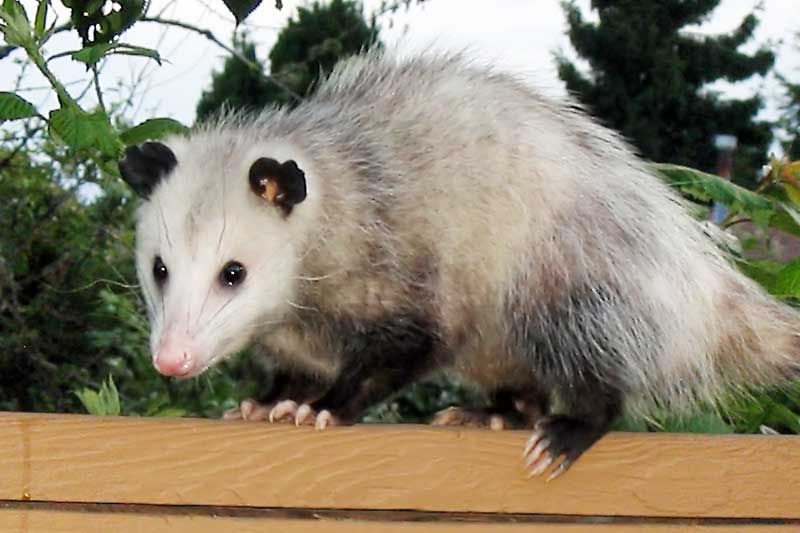Mar 18, 2015
By: Lorraine Julien
Though rarely seen because of their nocturnal habits, opossums have been slowly moving into southern Ontario from the eastern U.S. for quite a few years. This past winter would have been particularly cruel for this little animal from the south though - their tails and feet are pretty well hairless, leaving them especially prone to frostbite. Though they may look like big rats, they are actually quite gentle creatures. They are about the size of a house cat with mostly light-grey spiky fur.
Some of my family live in the country in the Port Perry area where they occasionally see wild (and not so wild) animals that may venture near their home looking for food. They have adopted a small family of feral cats. The cats are fed fairly regularly with kibble and kitchen scraps; however, another animal that has regularly joined the cats is an opossum. The little opossum has no fear of the cats and when it starts to eat their food, they jump back out of the way. We haven’t seen it this winter probably because of the severe cold.
I’m listing here some of the more unique facts you may find interesting about this animal:
First of all, is it an “opossum” or a “possum” and how did it come by this name? In the early 1600’s, a Capt. John Smith named the animal “opossum” from the word “opassum”, the Algonquian term meaning “white animal”. The proper name for North America’s only marsupial (pouched mammal) is the Virginia Opossum found in the U.S. and south eastern Canada.
Opossums have been around for millions of years (since the time of the dinosaurs) and are one of the Earth’s oldest surviving mammals. The animal was discovered in the tropical forests of South America. Until then, marsupials were only known to exist in Australia and Tasmania. As human populations increased northward in the Americas, the opossum followed, attracted, probably, by new food sources: road kill and garbage. Unfortunately it is obviously dangerous to eat road kill unless you are a crow with lightning reflexes!
Opossums have litters of up to 14 kits each about the size of a honey bee. Right after birth, the tiny creatures crawl into their mother’s pouch where they nurse for several months. After they’re mostly weaned, they leave the pouch from time to time and ride on their mother’s back until they mature.
Disease - They are naturally immune to rabies
Poison - They have almost total immunity to the venom of poisonous snakes
Garbage - They’ll eat almost anything, making them another of Mother Nature’s garbage collectors – items on the menu include road kill or anything dead, rodents, insects, snails, slugs, birds, eggs, frogs, plants, fruits and grains.
Brains - They are actually quite smart – they have a remarkable ability to find food and remember where it is. When tested for this skill, they scored much better than rabbits, cats and dogs. Another test showed that they could find their way through a maze more quickly than many other animals.
Natural Pest Control – since they like to eat slugs, beetles and snails, they are a welcome addition to the garden. They will kill rats, other rodents and cockroaches they find in their territory.
Thumbs – The opossum has opposable “thumbs”. The opposable thumbs are on the rear feet (technically they’re toes) which enable it to have fantastic climbing skills. Primates are the only other animals with these “thumbs”.
Impressive Tails – They have prehensile tails (meaning the tail can grasp and wrap around things like tree branches). Some people think they sleep hanging upside down but this is not the case. They’ve been seen carrying bundles of grass and other materials by looping their tails around the bundles. The tail works like a fifth appendage or hand.
Great Eyesight – the eyes appear to be black but it’s just that their pupils are strongly dilated; there is iris around them but it’s mostly out of sight. The giant pupils are thought to be adapted from their nocturnal habits.
Natural Defence – You’ve all heard the expression “play possum” – when possums are threatened they may run, growl or whatever but when all else fails, they “play possum” and act as if they are dead. It’s not a conscious act but is an involuntary, trance-like state that can last up to four hours. It has proven quite effective as a deterrent to predators looking for a meal.
Though opossums may look fearsome with a mouthful of teeth (50 – the most of any land mammal), these interesting and misunderstood little animals are quite gentle and quietly go about their business, mostly eating rodents and bugs. As long as we have winters like the past couple, it’s doubtful their numbers will increase to any extent here in the near future. It is possible though that we may see them in the Land O’ Lakes as they do like to be near water.
More Stories
- Province clarifies stance - Says Private Well Water Testing Will Continue
- Frontenac County Stays Internal for CAO - Appoints Kevin Farrell
- Addington Highlands Tax Bill Going Up 6.93%
- Perth Road United Church Donation to The Grace Centre
- 21 Years Of Dump Life Left At South Frontenac Waste Site
- Eclipse 2024 – Once In A Lifetime
- National Tourism Week
- NeLL Spring Open House and Anniversary Concert
- 25 years at Bishop Lake Outdoor Centre
- Grounds Contracts Down, Custodial Contracts Up In Central Frontenac

